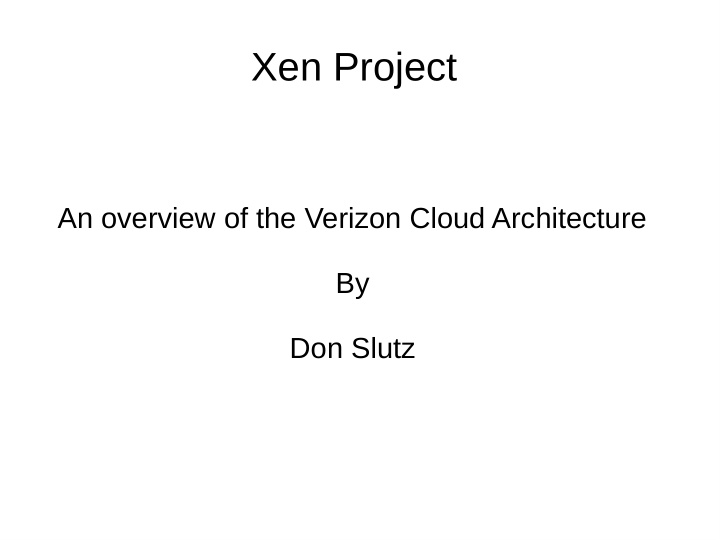



Xen Project An overview of the Verizon Cloud Architecture By Don Slutz
Design Goals ● Next Generation Cloud (start from scratch) ● Minimal people to support cloud ● Big ( i.e. fully scalable) ● Quality of Service ● Reliability ● Run any imported guest VM unchanged ● Worldwide ● All things can be done via API
Data Centers ● Culpeper, VA, USA ● Santa Clara, CA, USA ● Denver, CO, USA ● Sao Paulo, Brazil ● Miami, FL, USA ● London, United Kingdom ● Amsterdam, Netherlands
Data Center POD MRS MRS Router Router Internet CORE CORE CORE CORE SeaMicro SeaMicro SeaMicro SeaMicro SeaMicro SeaMicro
A total of 2 Managed Routing Service (MRS) connections consisting of 4 10Gbe over single mode fiber connections that are connected to CORE switches 1, 2, 3, and 4. The 4 CORE switches are connected via 10Gbe to all SeaMicro chassis. Up to 144 SeaMicro sm15000-op or sm15000-xn with 64 2TB STEC solid state disk drives.
We have 56 Xen servers, 8 storage servers and 8 level 2 switches in each SeaMicro chassis. All guest network traffic is sent on it's own VLAN inside a chassis and over a (maybe different) VLAN to the CORE switches. All the rest of the code runs as guests on the Xen servers.
Targeted Console Support ● Fully support VGA console ● Fully support serial console This includes interacting with the BIOS and/or grub (or other boot loader) during start-up.
Parts of VMware guest support. ● Linux is not so picky (PCI devices can move) ● Windows cares a lot (will cause re-activation) Newer VMware guests are closer. Older ones need more special device support in QEMU like LSI 1068 (sas), 1068e (sas on PCIe), and 53c1030 (older). Also, there are the VMware network adapters: vmxnet1, vmxnet2, and vmxnet3. These devices also need to be supported in seabios.
VMware likes to make lots of VMware style PCI-bridges. There is also an AGP-bridge that I have not found anything on it. VMware has been the most supported. In plan is handling other virtualization like Hyper-V, etc.
From VMware's web site: http://kb.vmware.com/selfservice/microsites/search.do?language=en_US&cmd =displayKC&externalId=1009458 Mechanisms to determine if software is running in a VMware virtual machine (1009458): ● Testing the CPUID hypervisor present bit and CPUID leaf 0x40000000. ● Testing the virtual BIOS DMI information ● Testing the hypervisor port Since even with VMware saying you should check these in order, not all software does; so, all three of these needed to be added. The hypervisor port is also known as VMware tools back-door or VMware hypercall interface. Note: Older Linux incorrectly looks for VMware not in smbios serial data (it checks via dmi_name_in_vendors() which is several smbios fields but not serial), new Linux does (via dmi_name_in_serial()). And VMware says to look for "VMware-", Linux only looks for "VMware".
VMware has 4 PCI bridges that are not currently in QEMU: ● A different model HOST bridge: 82443 (currently 82441). ● An AGP PCI bridge: 82443BX/ZX/DX AGP bridge ● A VMware Inc PCI bridge. ● A VMware Inc PCIe bridge. Currently hvmloader does not handle the number of PCI bridges that VMware likes to build. 1 PCI, 32 PCIe. The strange part is that with an AGP bridge, the VGA is not on it. For Windows, where the PCI devices are on the PCI Bridges matters. So we needed to enable more control of where a given PCI device ends up. This was done by adding bus= and addr= to vifs.
As part of Quality of Service (QoS) bps_rd, bps_wr, bps, iops_rd, iops_wr, and iops were added to disks and as well as a new top level limits= with sub options bps_rd, bps_wr, iops_rd, and iops_wr. We can also adjust where QEMU places default PCI devices. VMware also changed how various PCI devices look based on the VMware hardware version. Another part of VMware is that you can change memory layout by adjusting the size of the PCI (mmio) hole that is below 4G.
One of the most useful of all of these is the "VMware mouse". Since this is an absolute position mouse, with both Linux and Windows it is much nicer to use over slower networks.
An area that has not been fully investigated is the detection and handling of multiple hypervisor interfaces. Currently XEN has part of two: ● Xen ● viridian (Microsoft's HyperV). We have added a third, VMware. So are all presented? Only one? Some combination?
Recommend
More recommend